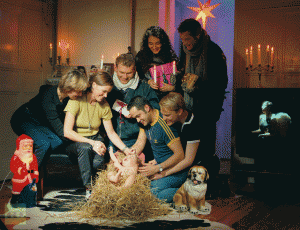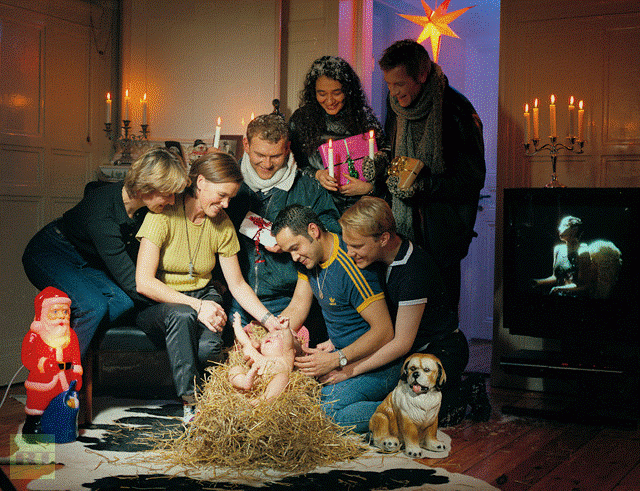Cross-posted from JohnFeffer.com. John is currently traveling in Eastern Europe and surveying its transformations since 1989.

By Swedish artist Elisabeth Ohlson Wallin.
I’m sorry I missed the excitement. By the time I made it to the Center for Cultural Decontamination, where the exhibition had a one-day showing, the exhibit was gone. There were plenty of police still hanging around the center’s courtyard with nothing to do, as if to ensure that the place was truly “decontaminated.” Since its founding in 1994, this center has been one of the most courageous pockets of resistance to nationalism, xenophobia, and intolerance in Serbia, and I’ll go back to interview the director, Borka Pavicevic.
The bigger controversy, however, was the decision of the Serbian interior ministry to cancel the Pride march on Saturday. There have been Pride marches and Queer Parades throughout the region, and many have attracted violent responses from neo-Nazis and skinheads. Violent demonstrators confronted marchers and the police at the Pride marches in Belgrade in 2001 and 2010, turning what should have been opportunities for the display of tolerance into ugly riots. The city authorities cancelled the march here in Belgrade last year as well, ostensibly to prevent violence but just as likely in response to pressure from religious and other groups.
The European Union has reacted strongly to the cancellation, basically telling the Serbian authorities to rein in the extremist elements and guarantee LGBT rights or risk further delays in accession. The current government of Tomislav Nikolic, of the rather conservative Serbian Progressive Party (an offshoot of the Serbian Radical party), has already expressed some reservations about fast-track membership in the EU, particularly if it requires recognition of an independent Kosovo. So, the EU’s stern response might not cause any sleepless nights for Nikolic and crew.
I was politically but also personally disappointed by the cancellation of the march because I had structured my itinerary so that I could be back in Belgrade to attend it. The events around Pride week are indeed a major test of how open Serbian society is becoming. I was struck by the superficial comparisons of the Ecce Homo exhibition to the recent controversy of the video, Innocence of Muslims. The latter was designed with the sole purpose of defaming Islam. The former draws on the teachings of Jesus who consistently stood with the marginalized. One preaches hate, the other love.
The message of standing with the marginalized should have particular resonance in Serbia these days, where the margins can often seem rather crowded. The EU focuses on ethnic, religious, and sexual minorities. But even though the Orthodox Church is overwhelmingly the dominant faith, only a fraction of the population actually goes to church regularly, leaving the truly faithful feeling beleaguered. And many ethnic Serbians themselves feel as if they are on the margins of Europe, forced by more powerful countries to give up historic Kosovo and pushed nearly to the end of the line for EU membership.
Marginality is, of course, relative. My interpreter in Bulgaria spoke wistfully of how much better things were for Serbia.
“Really?” I asked. “After all that Serbia has gone through over the last 20 years? War, sanctions, refugees – ”
“Yes,” she said. “But they have Novak Djokovic, one of the top tennis players in the world. Don’t underestimate the importance of having a winner like that for the national psyche.”
And then there are all the Serbians who don’t live in Belgrade. According to a recent study of the news media by the National Coalition for Decentralization (NKD), only 17 seconds of the national TV news report is devoted to events outside the capital. Talk about marginalization! Milos, my interpreter in the lovely city of Nis, told me that 1,500 people a day move to Belgrade (other cited figures are lower, 300-500, but still sobering). The countryside is emptying out. The young and the talented, if they aren’t leaving Serbia altogether, gravitate to the capital.
It’s a shame, since Nis should be a thriving center of southern Serbia. The city is dominated by an enormous Ottoman-era fortress built on the foundations of a Roman outpost. Inside this well-preserved structure are cafes, an art gallery in a former mosque, a lapidarium of exquisite Roman fragments. Nis is an historic crossroads, the former Naissus where the Roman emperor Constantine was born in 272 AD. During the second Crusade, Serbian leader Stefan Nemanja had a historic meeting in Nis with Frederick Barbarossa. Stefan ate with a fork, according to a story dear to the heart of all Serbians, while Frederick ate with his hands (this symbol of Serbian civilization is immortalized in the powerful anti-war film Pretty Village, Pretty Flames). The city continues to be a crossroads, a busy bus portal halfway between Belgrade and Skopje and on the way from Sofia to Sarajevo.
The downtown is full of cafes, which are in turn full of people. This gives Nis a festive air, though my interpreter explained that unemployment means that people have lots of time on their hands to sit around and drink coffees. With Belgrade the artistic center of the country, the provinces are starved of culture. For a ten-year period until recently, Nis didn’t even have a movie theater.
My guide to Nis was Mladen Jovanovic, who runs NKD and is passionately devoted to decentralization. Distributing power more equitably around the country is essential to providing Serbians with a voice in their public affairs. The municipalities don’t even own the public facilities – the airport, the public buildings – because these remain in the hands of the national authorities. Investment is highly centralized. Politics is controlled through Belgrade, and the MPs from the regions are more likely to represent their parties than their constituents.
The issue of decentralization is critical to Serbia’s future. The regions of Vojvodina and Sandzak have pushed for greater autonomy. The European Union requires a measure of decentralization as part of the membership process. The conservatives in Belgrade raise the specter of disintegration. But Mladen points out that a refusal to decentralize responsibly will only produce greater resistance and provoke an increase in separatist sentiment.
Our conversation takes place over several hours at a mehana, or tavern, where we eat grilled rib meat and skewers of chicken livers wrapped in bacon, along with roasted lamb and potatoes and three different salads. This mehana, close to the wall of the fortress and next to a tennis club, brews its own brandy, and we sip from little flagons of their quince rakia. The mayor is sitting several tables away, conferring with his associates. The weather is perfect. The thwack of tennis balls hitting racquets fills the air.
Nis seems, at this moment, like such a sensible place to live, far from the bruising politics of Belgrade. All it needs, perhaps, is what Richard Florida has called the “creative class,” young software engineers and artists and, yes, gay people. Someday, in some not-too-distant future, rainbow flags will appear on the streets of Nis, and the margins in Serbia will be the new center.

